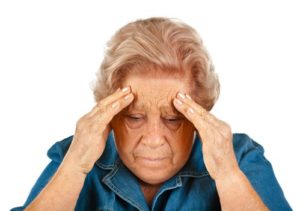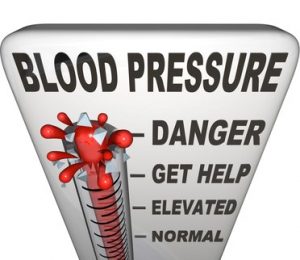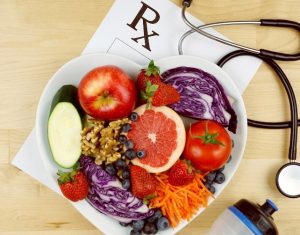Why Is Diet And Stroke Risk So Confusing?
 One day we are told vegetarian diets reduce our stroke risk. The next day we are told they increase stroke risk. It’s the same with red meat, dairy, and eggs. We keep getting mixed messages. It’s enough to make your head spin. Why is diet and stroke risk so confusing?
One day we are told vegetarian diets reduce our stroke risk. The next day we are told they increase stroke risk. It’s the same with red meat, dairy, and eggs. We keep getting mixed messages. It’s enough to make your head spin. Why is diet and stroke risk so confusing?
Part of the problem is that there are two distinct types of stroke. The technical names for them are ischemic stroke and hemorrhagic stroke.
An ischemic stroke occurs when an artery in the brain becomes blocked, shutting off blood flow and damaging part of the brain. This is usually caused by the gradual buildup of fatty deposits and cholesterol plaques in the arteries. When a blood clot forms and lodges in one of the narrowed arteries leading to the brain, an ischemic stroke occurs.
- Ischemic strokes account for 87% of all strokes.
- Ischemic strokes are associated with obesity, elevated cholesterol, diabetes, high blood pressure, and smoking.
A hemorrhagic stroke occurs when a weakened blood vessel bursts and bleeds into the surrounding region of the brain. Because our brains are surrounded by a protective skull, that blood has nowhere to go. Pressure from the buildup of blood damages brain cells in the vicinity of the bleed.
- Hemorrhagic strokes account for only for only 15% of strokes but are responsible for 40% of stroke deaths.
- The most common cause of a hemorrhagic stroke is the localized enlargement of a blood vessel due to chronic high blood pressure. This weakens the wall of the blood vessel, making it prone to rupturing.
Part of the confusion about diet and stroke risk is because many earlier studies did not distinguish between the two types of stroke.
- If the studies just measured the incidence of stroke, the data were dominated by ischemic strokes (87% of strokes are ischemic).
- However, if the studies focused on stroke deaths, hemorrhagic stroke made a larger contribution to the data set (40% of stroke deaths are hemorrhagic).
Fortunately, recent studies have started to focus on the effect of diet on ischemic and hemorrhagic strokes separately. However, many of those studies have been too small to accurately assess the effects of diet on hemorrhagic stroke.
The latest study (TYN Tong et al, European Heart Journal, ehaa007, published February 24, 2020) is one of the largest studies to look at the effect of diet on both kinds of stroke. It has enough patients in the hemorrhagic group to get an accurate estimate of the effect of diet on hemorrhagic stroke.
How Was The Study Done?
 This study analyzed data on diet and stroke from 418,329 participants in the EPIC (European Prospective Investigation into Cancer and Nutrition). Although the study has cancer in the title, it actually investigated the effect of nutrition on multiple diseases (Presumably, the study title was chosen because EPIC is a more appealing acronym than EPID (European Prospective Investigation into Diseases and Nutrition)).
This study analyzed data on diet and stroke from 418,329 participants in the EPIC (European Prospective Investigation into Cancer and Nutrition). Although the study has cancer in the title, it actually investigated the effect of nutrition on multiple diseases (Presumably, the study title was chosen because EPIC is a more appealing acronym than EPID (European Prospective Investigation into Diseases and Nutrition)).
The participants were recruited from 9 European countries (Denmark, Germany, Greece, Italy, the Netherlands, Norway, Spain, Sweden, and the UK). The average age of participants was 50, and they were followed for an average of 12.7 years.
At the beginning of the study participants completed country-specific dietary and lifestyle questionnaires.
The dietary assessment was a food frequency questionnaire that asked participants about their dietary intake for the year prior to enrollment in the study. The food frequency data were used to estimate daily intake of red meat, processed meat, poultry, fish, dairy products, eggs, grains, fruits, vegetables, legumes, nuts, seeds, and dietary fiber (It measured total fiber and fiber from grains, fruits and vegetables individually).
The outcome measured was the incidence of ischemic and hemorrhagic strokes during the 12.7-year follow-up.
Which Foods Affect Stroke Risk?
- Each 200 gram/day increase in consumption of fruits and vegetables decreased ischemic stroke risk by 13% (200 grams roughly corresponds to one large apple or one large orange without the skin).
- Each 10 gram/day increase in consumption of fiber decreased ischemic stroke risk by 23%. Most of this decreased stroke risk was due to fiber from whole grains, fruits, and vegetables.
-
- Each 4 gram/day increase in fiber from whole grains decreased ischemic stroke risk by 10%.
-
- Each 4 gram/day increase in fiber from fruits and vegetables decreased ischemic stroke risk by 12%.
- Dairy foods decreased ischemic stroke risk with the following breakdown:
-
- Each cup of milk decreased ischemic stroke risk by 5%.
-
- Each half cup of yogurt decreased ischemic stroke risk by 9%.
-
- Each ounce of cheese decreased ischemic stroke risk by 12%.
- Each 50 grams/day (2 ounces) of red meat increased ischemic stroke risk by 14%.
-
- However, red meat was only half as likely to increase risk of ischemic stroke when the diet was also rich in fruits, vegetables, whole grains, and legumes.
For hemorrhagic stroke:
- Each 20 gram/day increase in consumption of eggs increased hemorrhagic stroke risk by 25% (20 grams roughly corresponds to about 1/2 of a small egg or 1/3 of a jumbo egg).
- This study did not measure the effect of salt intake on hemorrhagic stroke risk.
No other foods measured in this study had a significant effect on hemorrhagic stroke risk.
 However, hemorrhagic stroke is highly associated with high blood pressure. When we look at the influence of foods on high blood pressure, here are the Harvard School of Medicine recommendations for keeping blood pressure low:
However, hemorrhagic stroke is highly associated with high blood pressure. When we look at the influence of foods on high blood pressure, here are the Harvard School of Medicine recommendations for keeping blood pressure low:
- Eat more fish, nuts and beans in place of high-fat meats.
- Choose fruits and vegetables instead of sugary, salty snacks and desserts.
- Select whole grains rather than refined grains.Eat fruit instead of drinking fruit juice.
- Use unsaturated fats like olive, canola, soybean, peanut, corn or safflower oils instead of butter, coconut oil, or palm-kernel oil.
- Use herbs, spices, vinegar, and other low-sodium flavorings instead of salt; Choose low-sodium foods whenever possible.
Why Is Diet And Stroke Risk So Confusing?
 As I mentioned at the start of this article, part of the reason that the headlines about diet and stroke risk are so confusing is:
As I mentioned at the start of this article, part of the reason that the headlines about diet and stroke risk are so confusing is:
- Many studies did not distinguish between the two types of stroke.
- Other studies were too small to reliably estimate the effect of food on hemorrhagic stroke risk.
However, there are still some unexplained inconsistencies among recently published studies. It is these inconsistencies I would like to address. For example:
1) In a recent issue of Health Tips From the Professor I reported on a major study (500,000 people followed for 8.9 years) in China. That study came to the opposite conclusion about eggs and risk of hemorrhagic than the EPIC study I discussed above. It found:
- People consuming one egg per day had a 26% decrease in hemorrhagic stroke risk and a 28% decrease in hemorrhagic stroke deaths compared to people who never or rarely consumed eggs.
In other words, the two studies came to opposite conclusions. In the China study eggs decreased risk of hemorrhagic stroke. In the European study (EPIC) eggs increased risk of hemorrhagic stroke. The reason for this discrepancy is not clear, but one can speculate it might be explained by differences in the underlying diets of the two countries:
- In China the diet is primarily plant-based. The addition of an egg/day may provide needed protein, fat, and cholesterol (Some cholesterol is essential. We just overdo it in this country).
- In Europe the diet is already high in protein, saturated fat, and cholesterol. Getting more of them from eggs may not be such a good thing.
In short, if your diet is primarily plant-based, the addition of an egg/day may be a good thing. However, if your diet is already high in meat, saturated fat, and cholesterol, the addition of an egg/day may not be a good thing.
 2) In another recent issue of Health Tips From the Professor I reported on the EPIC-Oxford study that claimed vegetarians had 20% increased risk of hemorrhagic stroke compared to meat eaters.
2) In another recent issue of Health Tips From the Professor I reported on the EPIC-Oxford study that claimed vegetarians had 20% increased risk of hemorrhagic stroke compared to meat eaters.
Interestingly, the EPIC-Oxford study represented a very small portion (~10%) of the overall EPIC study and differed from the rest of the EPIC study in two important ways.
- It looked at the effect of diets rather than foods on stroke risk.
- Oxford was the only one of the 22 research centers involved in the EPIC study to invite people following a vegetarian diet to enroll in the study, so it had a much higher proportion of vegetarians than other centers that participated in the study.
The current study did not find any evidence that fruits, vegetables, nuts, seeds, beans, or whole grains influenced the risk of hemorrhagic stroke. In other words, in this much larger data set there was no evidence that the foods associated with a vegetarian diet increased hemorrhagic stroke risk.
However, most of the participants in larger EPIC study were also eating meats. They were not following a pure vegetarian diet.
As I said previously, “If the data on hemorrhagic stroke risk in the EPIC-Oxford study are true, it suggests it may not be a good idea to completely eliminate meat from our diet. However, you don’t need to add much meat to a vegetarian diet. The fish eaters in this study were consuming 1.4 ounces of fish per day. That was enough to eliminate the increased risk of hemorrhagic stroke.”
What Does This Mean For You?
 For ischemic stroke (blockage of blood flow to the brain), which is the most common form of stroke, the data are clear cut:
For ischemic stroke (blockage of blood flow to the brain), which is the most common form of stroke, the data are clear cut:
- Fruits, vegetables, whole grains and dairy foods are good for you. (Your mother was right.)
- Red meat is not so good for you. However, the bad effect of red meat on ischemic stroke risk can be reduced by including plenty of fruits, vegetables, and whole grains in your diet.
- These conclusions are consistent with multiple previous studies, and the mechanisms of these effects are well established.
For hemorrhagic stroke (bleeding from a weakened blood vessel in the brain) the data are not as clear cut.
- If you are consuming a primarily plant-based diet, eggs appear to reduce your risk of hemorrhagic stroke.
- If you are consuming a diet with lots of meat, saturated fat, and cholesterol, adding eggs may increase your risk of hemorrhagic stroke.
- A vegetarian diet may increase your risk of hemorrhagic stroke. But you don’t need to add much meat to a vegetarian diet. Consuming 1.4 ounces of fish per day appears to be enough to eliminate the increased risk of hemorrhagic stroke.
- The mechanisms of these effects of food on hemorrhagic stroke are unclear, so these conclusions may be modified by subsequent studies.
In terms of an overall take-home lesson on diet and stroke risk, my advice is: “A primarily plant-based diet is a good idea, but you don’t need to become a vegan purist. Nor do you want to follow fad diets that eliminate whole food groups. We have 5 food groups for a reason. Eliminating any of them may not be a good idea.”
The Bottom Line
A recent study examined the effect of various foods on the risk of the two major forms of stroke.
For ischemic stroke (blockage of blood flow to the brain), which is the most common form of stroke, the data are clear cut:
- Fruits, vegetables, whole grains and dairy foods are good for you. (Your mother was right.)
- Red meat is not so good for you. However, the bad effect of red meat on ischemic stroke risk can be reduced by including plenty of fruits, vegetables, and whole grains in your diet.
- These conclusions are consistent with multiple previous studies, and the mechanisms of these effects are well established.
For hemorrhagic stroke (bleeding from a weakened blood vessel in the brain) the data are not as clear cut.
- If you are consuming a primarily plant-based diet, eggs appear to reduce your risk of hemorrhagic stroke.
- If you are consuming a diet with lots of meat, saturated fat, and cholesterol, adding eggs may increase your risk of hemorrhagic stroke.
- A vegetarian diet may increase your risk of hemorrhagic stroke. But you don’t need to add much meat to a vegetarian diet. Consuming 1.4 ounces of fish per day appears to be enough to eliminate the increased risk of hemorrhagic stroke.
- The mechanisms of these effects of food on hemorrhagic stroke are unclear, so these conclusions may be modified by subsequent studies.
In terms of an overall take-home lesson on diet and stroke risk, my advice is: “A primarily plant-based diet is a good idea, but you don’t need to become a vegan purist. Nor do you want to follow fad diets that eliminate whole food groups. We have 5 food groups for a reason. Eliminating any of them may not be a good idea.”
For more details, read the article above.
These statements have not been evaluated by the Food and Drug Administration. This information is not intended to diagnose, treat, cure or prevent any disease.

